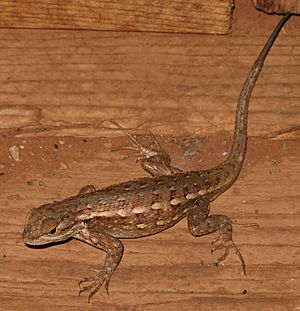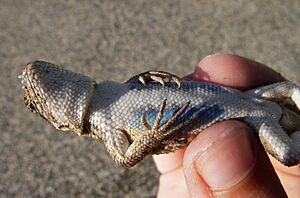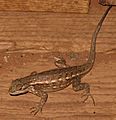Sagebrush lizard facts for kids
Quick facts for kids Sagebrush lizard |
|
|---|---|
 |
|
| Scientific classification |
The sagebrush lizard (Sceloporus graciosus) is a common type of lizard. It lives in the western United States in places that are medium to high up, like mountains. This lizard is part of a group called Sceloporus, also known as spiny lizards.
It gets its name from the sagebrush plants where it often lives. The sagebrush lizard has special scales that feel like they have a ridge or spine, especially on its back.
The sagebrush lizard looks a lot like the western fence lizard, which also lives in the western US. You can tell them apart because the sagebrush lizard is usually smaller. It also has finer scales. Its back scales are often gray or tan, but they can be other colors too. It has a lighter stripe down the middle of its back. There are also two light stripes, one on each side. Sometimes, sagebrush lizards have orange marks on their sides.
There are three main types of sagebrush lizards. The southern type lives in Southern California. The western and northern types are found in many western states. These include Oregon, Idaho, Colorado, Montana, Washington, New Mexico, Utah, Wyoming, and Arizona.
Contents
What Does the Sagebrush Lizard Look Like?
Adult sagebrush lizards are usually about 4.7 to 8.9 centimeters (1.9 to 3.5 inches) long from their nose to the base of their tail. Baby lizards are much smaller, about 25 millimeters (1 inch) long.
Sagebrush lizards are often gray, brown, or olive green. They might have hints of blue or green on their backs. They often have wavy patterns on their bodies and tails. Many also have a black bar on their shoulder. They have a light line on each side of their body. The skin near their armpits and on their sides can be a rusty color.
Female lizards have white or yellow bellies. Male lizards have bright blue patches on their bellies and throats. Sometimes the throat patch is missing. Males also have larger scales near their tail and two swollen areas at the base of their tail. During the time they mate, males might turn orange. Young lizards look like adults, but they don't have the dark blue markings.
Where Do Sagebrush Lizards Live?
Sagebrush lizards live across much of the western United States. You can find them in Utah, Nevada, southern Idaho, northern Arizona, and parts of New Mexico and Colorado. They also live in Wyoming, Oregon, California, and Washington. You might even find small groups in North Dakota and Nebraska.
These lizards can live at many different heights, from about 150 meters (500 feet) up to 3,200 meters (10,500 feet) above sea level.
What is Their Home Like?
Sagebrush lizards are often seen in areas with shrubs. But they also live in other places like pine forests and woodlands with juniper trees. They like to warm up in the sun on logs and rocks. They spend most of their time on the ground. However, they can climb trees to escape from animals that might try to eat them.
How Do Sagebrush Lizards Behave?
Sagebrush lizards get scared easily. If they feel danger, they quickly hide in cracks, bushes, animal burrows, or trees. Sometimes, though, they might stay very still and pretend to be dead.
These lizards warm themselves in the sun on the ground, on low branches, or on small rocks. When it gets cold, they might hide in animal burrows or rock cracks to sleep through the winter. They are mostly active during the day. They are usually active from March or April until late September or early October. Young lizards stay active a bit later in the fall than adults.
Sagebrush lizards don't usually travel far from their homes. They might move a little to find good places to lay eggs or to find winter hiding spots. Male lizards move around more than females, especially in the spring. They also have larger home areas, but these areas are still quite small.
During the winter, sagebrush lizards go into a deep sleep called brumation. How long they sleep depends on the weather where they live. In Idaho, adults are active from mid-April to September. Young lizards are most active in August. In Washington, these lizards often live in sandy areas like sand dunes. They like places with shrubs and open ground.
Sagebrush lizards warm up in the sun in the morning and late afternoon. They often sit on the ground at the edge of bushes or other plants that offer cover. When the ground gets too hot, they move into the low branches of shrubs or under plants. At night, on rainy days, or on cool, windy days, they go underground or hide under things.
Sagebrush lizards eat many kinds of insects. These include ants, beetles, grasshoppers, flies, and moths. They also eat spiders. In places where they live near western fence lizards, they might compete for the same food.
Reproduction and Life Cycle
Male sagebrush lizards protect their areas both during and after the time they mate. They do this by showing off and sometimes by fighting. Male and female lizards' territories overlap. This allows males to find and mate with a few females they know. Courtship involves head bobs and shaking movements. This takes a lot of energy and time. Males are usually a little bigger than females.
Sagebrush lizards mate in the spring. Females lay one or two groups of eggs, usually 2 to 10 eggs per group. They lay their eggs from late spring to midsummer. The eggs are laid about 2.5 centimeters (1 inch) deep in loose soil, often near the bottom of a shrub. The eggs hatch in about 45 to 75 days (around two months). Females in the northwestern areas might lay two groups of eggs. Young lizards can start having their own babies when they are one year old (in the southern areas) or two years old (in the northern areas).
Who Eats Sagebrush Lizards?
Sagebrush lizards are an important food source for many animals in the western United States. Snakes, especially striped whipsnakes and night snakes, are their main predators. But birds of prey also eat a lot of them. Smaller meat-eating mammals and even pet cats also hunt them. Sometimes, changes to their habitat from human activities can affect these lizards.
Types of Sagebrush Lizards
There are three recognized types of sagebrush lizards. They are different in where they live, their markings, and how many scales they have.
- Sceloporus graciosus graciosus – This is the northern sagebrush lizard.
- Sceloporus graciosus gracilis – This is the western sagebrush lizard.
- Sceloporus graciosus vandenburgianus – This is the southern sagebrush lizard.
Images for kids




